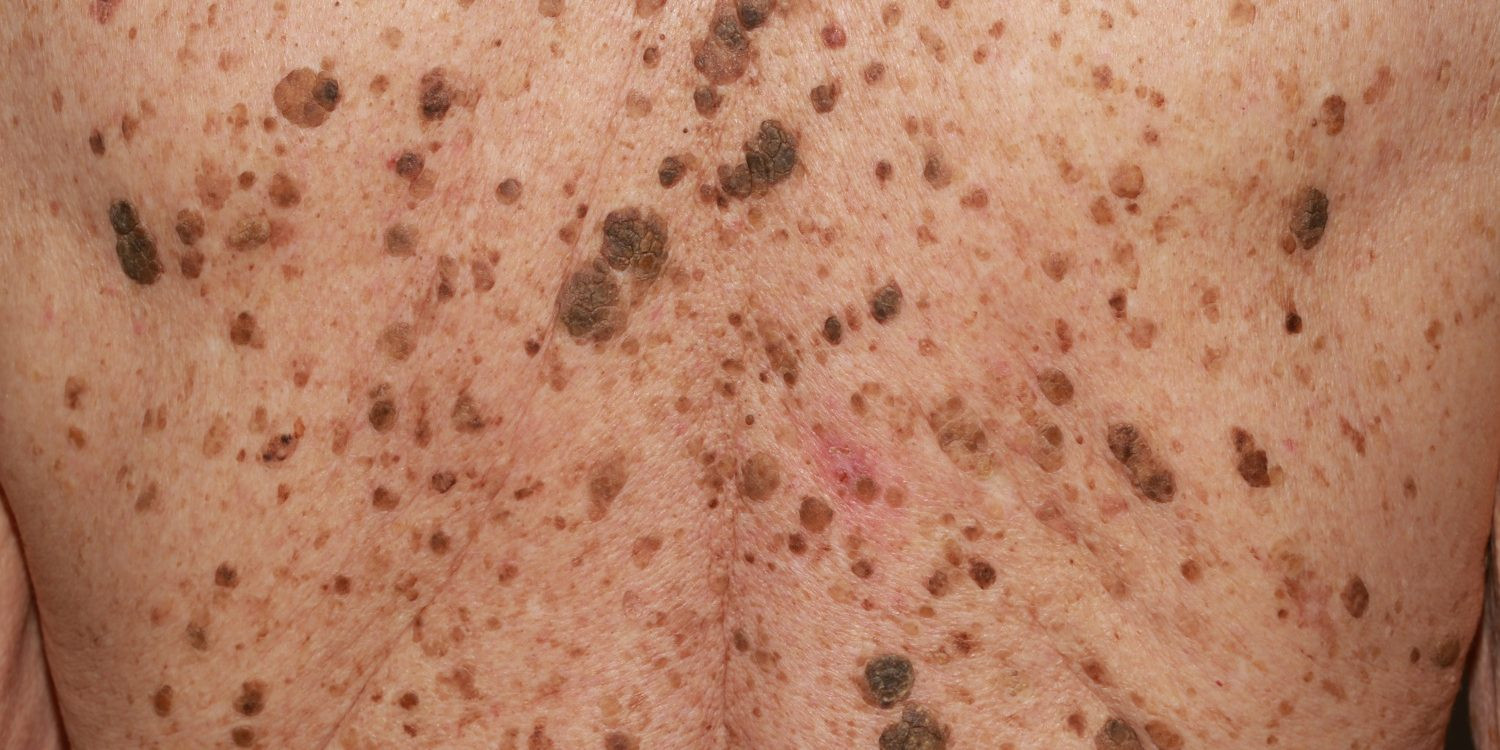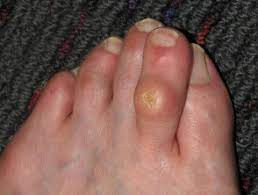Definisi
Keratosis seboroik atau keratosis senilis adalah pertumbuhan kulit yang sering terjadi dan tampak sebagai tonjolan. Pertumbuhan ini bukanlah pertumbuhan yang ganas seperti kanker, dan jumlahnya bertambah banyak seiring usia. Namun, keratosis sering disalahpahami sebagai kanker kulit karena bentuknya. Keratosis senilis tidak berbahaya dan tidak menular. Umumnya orang akan mengalami keratosis seboroik minimal satu kali dalam hidupnya. Namun, dokter bisa membantu menghilangkannya jika Anda merasa terganggu dengan kondisi tersebut, baik dari segi penampilan atau karena mudah tergesek pakaian.
Keratosis seboroik biasanya berwarna coklat, hitam, atau coklat muda. Pertumbuhan ini dapat terlihat seperti lilin atau bersisik dan sedikit menonjol. Benjolan muncul secara bertahap dan dapat tumbuh di mana saja, kecuali di telapak tangan dan kaki atau di selaput lendir mulut dan hidung. Bagian tubuh yang sering menjadi lokasi kemunculan keratosis seboroik adalah wajah, leher, dada, bahu, punggung, dan lipatan kulit.
Berdasarkan studi tahun 2015, keratosis seboroik ditemukan pada sekitar 83 juta orang di Amerika Serikat. Sementara di Inggris, 30% orang memiliki keratosis seboroik pada usia 40 tahun. Ketika menginjak usia 70 tahun, 75% dari mereka akan mengalami keratosis seboroik.
Penyebab
Keratosis seboroik terjadi ketika sel-sel kulit tumbuh secara tidak normal. Namun, penyebab dari keratosis masih belum diketahui secara pasti. Pertumbuhan kulit ini pada umumnya terjadi pada keluarga, sehingga ada kemungkinan bahwa kondisi ini diturunkan. Jika Anda memiliki satu keratosis seboroik, risiko keratosis ini bertambah semakin tinggi. Kondisi ini tidak berbahaya dan tidak menular.
Faktor Risiko
Faktor risiko dari keratosis seboroik atau keratosis senilis adalah sebagai berikut:
1. Usia Tua
Kondisi ini biasanya pertama kali muncul pada usia 30-an atau 40-an, dan risikonya meningkat seiring usia. Kondisi ini sangat jarang terjadi pada orang-orang yang berusia di bawah 20 tahun.
2. Adanya Anggota Keluarga dengan Keratosis
Kondisi kulit ini umumnya terjadi pada keluarga, dan seringkali dapat diwariskan. Risiko kondisi ini meningkat seiring dengan peningkatan jumlah anggota keluarga yang mengalami hal serupa.
3. Hamil dan Terapi Hormonal
Keratosis seboroik dapat muncul saat hamil. Pertumbuhan kulit ini juga dapat terjadi apabila seseorang menjalani terapi hormonal pengganti estrogen (misalnya pada wanita menopause).
4. Sering Terpapar Sinar Matahari
Penelitian menunjukkan bahwa salah satu tipe keratosis seboroik, yaitu tipe adenoid, lebih sering terjadi pada kulit yang terpapar matahari dibandingkan dengan kulit yang terlindungi. Namun, keratosis senilis juga dapat terjadi pada bagian kulit yang tertutup saat beraktivitas di luar ruangan.
5. Memiliki Warna Kulit yang Lebih Cerah
Keratosis seboroik lebih sering terjadi pada orang-orang dengan kulit putih, namun hal ini tidak menutup kemungkinan bahwa orang berkulit gelap dapat mengalaminya juga.
Gejala
Keratosis seboroik biasanya tumbuh secara bertahap. Tanda dan gejala dapat berupa:
- Benjolan berbentuk bulat atau lonjong, seperti lilin atau agak kasar, biasanya pada wajah, dada, bahu, atau punggung
- Pertumbuhan kulit yang agak datar atau sedikit lebih tinggi daripada kulit dengan permukaan bersisik, seperti “ditempel”
- Ukuran bervariasi, mulai dari sangat kecil hingga 1 inci (2,5 sentimeter)
- Jumlah bervariasi, mulai dari tunggal hingga jamak
- Pertumbuhan kulit yang sangat kecil, berkumpul di daerah dekat mata atau area wajah lainnya, kadang disebut sebagai tahi lalat atau dermatosis papulosa nigra, dan sering terjadi pada kulit coklat atau hitam
- Warna bervariasi, mulai dari agak gelap, kecoklatan, atau hitam
- Gatal atau iritasi
- Benjolan tersangkut pada pakaian atau perhiasan
Biasanya, benjolan ini muncul berukuran kecil dan kasar. Seiring dengan waktu, benjolan ini dapat bertambah besar dan tebal, dengan permukaan mirip kutil. Benjolan ini tampak seperti “ditempel”, atau tampak seperti lilin atau minyak dan permukaannya sedikit meninggi dari kulit. Benjolan ini dapat muncul pada kulit kepala, wajah, dada, bahu, perut, dan punggung.
Diagnosis
Diagnosis keratosis seboroik atau keratosis senilis biasanya cukup dengan pengamatan kulit saja. Dokter akan bertanya mengenai keluhan serta bagaimana riwayat kesehatan dari pasien dan keluarganya. Jika ada ketidakpastian atau diperlukan pemeriksaan penunjang, dokter akan berusaha untuk mengambil bagian dari benjolan untuk diperiksa di laboratorium. Pemeriksaan ini disebut sebagai biopsi kulit. Sampel dari biopsi ini akan dilihat di bawah mikroskop oleh ahli patologi anatomi. Pemeriksaan ini dapat membantu dokter mendiagnosis benjolan sebagai keratosis seboroik atau kondisi lainnya.
Tata Laksana
Keratosis seboroik atau keratosis senilis pada umumnya tidak berbahaya, sehingga tidak memerlukan tata laksana. Namun, dokter dapat mengambil benjolan apabila terlihat seperti kanker kulit, tersangkut pada pakaian atau perhiasan, mudah teriritasi, atau tampak mengganggu penampilan.
Tata laksana lainnya yang mungkin dilakukan untuk keratosis adalah sebagai berikut:
1. Krioterapi
Dokter akan menggunakan nitrogen cair yang sangat dingin untuk dioleskan atau disemprotkan ke benjolan. Nitrogen cair ini dapat menghancurkan benjolan. Kemudian, keratosis dapat jatuh dengan sendirinya setelah beberapa hari. Kadang-kadang, dapat terjadi luka pada area bekas keratosis, yang mengering membentuk koreng. Koreng ini dapat hilang sendirinya
2. Electrosurgery dan Kuretase
Prosedur electrosurgery atau kauterisasi dilakukan dengan melumpuhkan benjolan dengan obat bius, kemudian menggunakan arus listrik untuk menghancurkannya. Setelah itu, alat kuret yang berbentuk seperti sekop, akan digunakan untuk mengikis benjolan yang sudah dihancurkan. Prosedur ini disebut sebagai kuretase. Pasien tidak membutuhkan jahitan, meskipun dapat terjadi sedikit perdarahan. Kadang, pasien hanya membutuhkan kauterisasi atau kuretase saja.
3. Eksisi
Mirip dengan kuretase, prosedur eksisi dilakukan untuk memotong keratosis. Dokter juga dapat melakukan eksisi untuk mengirim sampel jaringan untuk diperiksa di laboratorium.
4. Ablasi
Prosedur ini menggunakan laser khusus untuk menguapkan benjolan.
5. Larutan Hidrogen Peroksida
Larutan hidrogen peroksida dengan konsentrasi 40% dapat merusak sel-sel pada keratosis seboroik. Namun, obat ini hanya dapat digunakan dengan resep dokter.
6. Larutan asam nitrat-seng
Larutan ini dapat mengecilkan atau menghilangkan keratosis seboroik secara utuh dalam waktu 6 bulan.
Untuk mencegah perdarahan, peradangan, atau infeksi, sebaiknya Anda tidak mencoba untuk mengambil keratosis sendiri dengan mencabut atau menggaruknya. Setelah keratosis diambil, warna kulit Anda di bagian tersebut kemungkinan menjadi sedikit lebih terang. Perbedaan warna kulit ini akan semakin pudar seiring waktu. Keratosis senilis pada umumnya tidak akan kembali, namun mungkin muncul di bagian tubuh lainnya.
Komplikasi
Keratosis senilis atau seboroik merupakan kondisi yang tidak berbahaya dan tidak menular. Oleh karena itu, kondisi ini tidak memiliki komplikasi yang serius. Komplikasi yang mungkin terjadi akibat keratosis seboroik adalah tersangkutnya keratosis pada pakaian atau perhiasan, iritasi pada kulit, serta gangguan pada penampilan. Komplikasi juga dapat terjadi akibat usaha untuk mengambil keratosis sendiri, yaitu perdarahan, peradangan pada kulit, dan infeksi. Komplikasi akibat tindakan medis untuk mengambil keratosis senilis dapat berupa perdarahan dan warna kulit yang lebih terang pada daerah yang baru saja dicabut.
Pencegahan
Pencegahan keratosis seboroik sulit dilakukan, karena dapat terjadi dengan diwariskan dan tidak selalu tumbuh pada daerah yang terkena sinar matahari. Namun, pencegahan dapat dilakukan agar komplikasi keratosis seboroik tidak terjadi, misalnya dengan tidak berusaha untuk menangani kondisi ini tanpa bantuan dokter. Anda dapat meminta bantuan dokter untuk menangani kondisi ini jika dirasa mengganggu Anda dalam berpakaian, mudah iritasi, atau mengganggu penampilan Anda.
Kapan Harus ke Dokter?
Keratosis seboroik bukanlah kondisi yang parah, namun Anda sebaiknya tidak membiarkan benjolan pada kulit begitu saja. Membedakan keratosis seboroik dengan kanker kulit terutama melanoma dapat menjadi hal yang sulit. Anda dapat meminta dokter untuk memeriksa kulit Anda apabila:
- Ada pertumbuhan benjolan baru
- Ada perubahan pada benjolan lama
- Hanya ada satu benjolan (biasanya, keratosis muncul beberapa sekaligus)
- Benjolan memiliki warna yang tidak biasa, misalnya ungu, biru, atau merah kehitaman
- Benjolan memiliki batas yang tidak jelas, tidak rata, atau tidak teratur
- Benjolan terasa nyeri atau mudah iritasi
Jika Anda khawatir dengan benjolan, Anda dapat berkonsultasi pada dokter umum atau spesialis kulit. Anda sebaiknya tidak meremehkan kondisi yang kemungkinan dapat menjadi parah dan mengancam nyawa.
Mau tahu informasi seputar penyakit lainnya? Cek di sini, ya!
- dr Hanifa Rahma
O'Connell, K., Goldman, L., & Gathers, R. (2021). Understanding Seborrheic Keratosis, a Benign Skin Condition. Retrieved 9 May 2022, from https://www.healthline.com/health/seborrheic-keratosis
Seborrheic keratoses: Diagnosis and treatment. (2022). Retrieved 9 May 2022, from https://www.aad.org/public/diseases/a-z/seborrheic-keratoses-treatment
Seborrheic keratosis - Symptoms and causes. (2022). Retrieved 9 May 2022, from https://www.mayoclinic.org/diseases-conditions/seborrheic-keratosis/symptoms-causes/syc-20353878
Greco MJ, Bhutta BS. (2021). Seborrheic keratosis. Retrieved 27 April 2022, from https://www.ncbi.nlm.nih.gov/books/NBK545285/
Seborrheic keratosis. (2021). Retrieved 27 April 2022, from https://my.clevelandclinic.org/health/diseases/21721-seborrheic-keratosis










